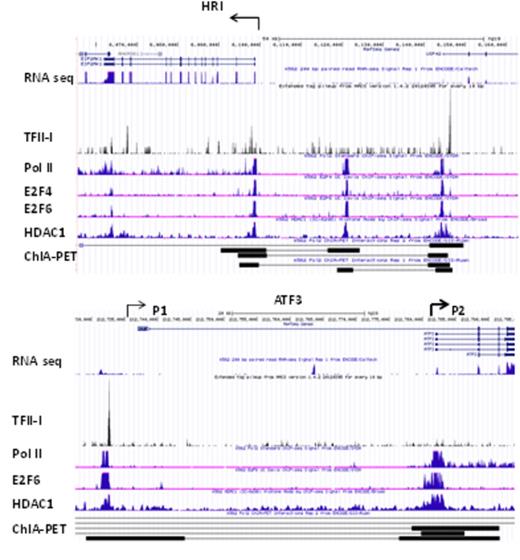The transcription factor ATF3 and the heme regulated eIF2α kinase (HRI) have previously been shown to be involved in the stress response in hematopoietic cells. Many stress-responsive genes are regulated at the level of transcription elongation and are characterized by paused RNA polymerase II (Pol II) at the promoter region. Indeed, analyzing data from the public ENCODE project revealed that the HRI and the ATF3 genes contained paused Pol II at the promoter and at upstream intergenic regulatory elements.
In this study we performed a genomic and proteomic analysis of transcription factor TFII-I (also known as GTF2I) in human erythroleukemia K562 cells. TFII-I is a ubiquitously expressed transcription factor previously implicated in regulating genes involved in stress response. TFII-I exhibits both positive and negative effects on transcription. TFII-I is a relatively large protein (about 120 Kda) and contains DNA binding, nuclear localization, and multiple protein/protein interaction domains. Using biotinylation tagging technology and high-throughput sequencing, we determined sites of chromatin interactions for TFII-I. This study revealed that TFII-I binds downstream of Pol II peaks at the ATF3 and HRI gene loci (Fig 1). A proteomic analysis revealed that TFII-I interacts with the elongation factor elongin A, which has been shown to help Pol II overcome the paused state. We demonstrate that Elongin A only associates with the ATF3 gene in response to cellular stress. The stress induction of ATF3 gene transcription requires the function of TFII-I. Furthermore, in the absence of induction, transcription factors E2F6, and E2F4 as well as the histone deacetylase I (HDAC1) bind to the HRI and ATF3 genes in close proximity to the Pol II and TFII-I peaks (Fig. 1). E2F4/6 and HDAC1 have been implicated in the repression of gene expression. The DNA elements that recruit TFII-I, Pol II and the repressor proteins interact over long distances in K562 cells as shown by ChIA-Pet data available from the ENCODE project (Fig.1). Moreover, we demonstrate that TFII-I directly interacts with E2F6 using co-immunoprecipitation assays (Fig. 2). Partial depletion of TFII-I by shRNA led to a decrease in stress mediated transcription without impairing basal transcription levels.
The data demonstrate that TFII-I regulates stress-responsive transcription of the HRI and ATF3 genes in hematopoietic cells. In the absence of stress, TFII-I occupies promoter and long distance regulatory elements together with Pol II, E2F6/E2F4, and HDAC1. These proteins may be part of a chromatin loop that keeps Pol II in a repressed configuration. We suggest that upon stress induction, TFII-I recruits Elongin A, which converts Pol II into a transcriptionally active configuration. Transcription elongation disrupts formation of a repressive chromatin loop and leads to transcription activation of the HRI and ATF3 genes.
Diagram of the HRI and ATF3 gene loci showing interactions of TFII-I, Pol II, E2F4, E2F6, and HDAC1 as well as RNA seq, and Pol II ChIA-PET data. The ChIA-PET data show interactions of chromatin fragments that have Pol II bound. The arrows indicate the direction of transcription of the HRI gene and from the two promoters of the ATF3 gene (P1 and P2).
Diagram of the HRI and ATF3 gene loci showing interactions of TFII-I, Pol II, E2F4, E2F6, and HDAC1 as well as RNA seq, and Pol II ChIA-PET data. The ChIA-PET data show interactions of chromatin fragments that have Pol II bound. The arrows indicate the direction of transcription of the HRI gene and from the two promoters of the ATF3 gene (P1 and P2).
Co-Immunoprecipitation experiment showing the interaction between TFII-I and E2F6. K562 cell nuclear extracts were subjected to precipitation with IgG control or TFII-I specific antibodies. The material was fractionated by SDS-PAGE, transferred to a nylon membrane and probed with an antibody specific for E2F6.
Co-Immunoprecipitation experiment showing the interaction between TFII-I and E2F6. K562 cell nuclear extracts were subjected to precipitation with IgG control or TFII-I specific antibodies. The material was fractionated by SDS-PAGE, transferred to a nylon membrane and probed with an antibody specific for E2F6.
No relevant conflicts of interest to declare.
Author notes
Asterisk with author names denotes non-ASH members.




This feature is available to Subscribers Only
Sign In or Create an Account Close Modal